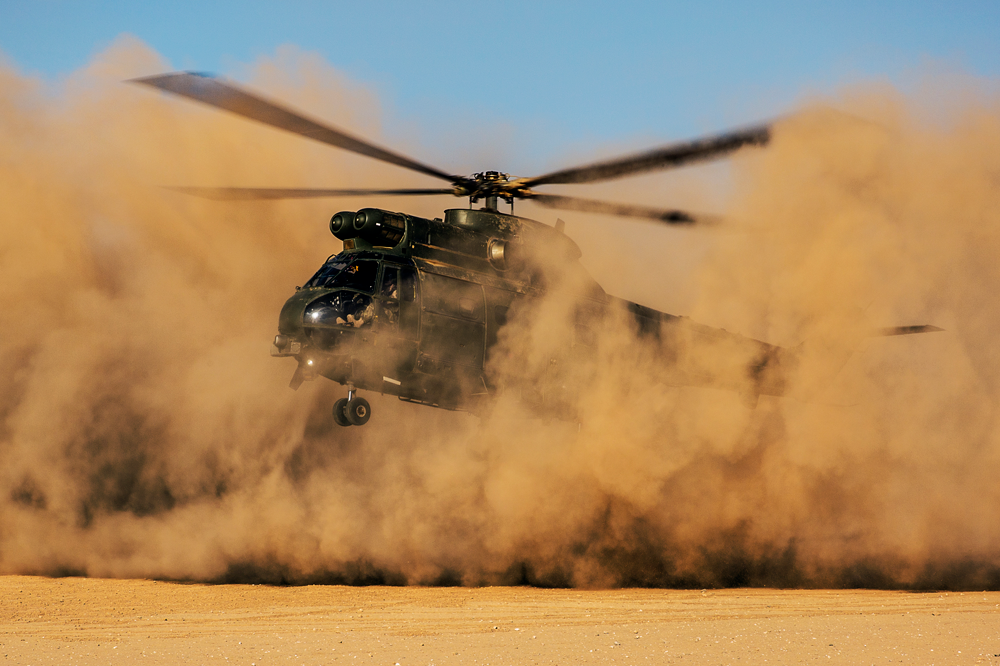About the Puma HC2
ROLE
The Puma HC.Mk 2 medium support helicopter operates under Joint Helicopter Command (JHC) control. The aircraft is used in a variety of combat roles, including the tactical movement of troops, weapons, ammunition and stores on the battlefield, as well as the extraction of casualties and in response to medical emergencies on the frontline. It is also employed during non-combatant evacuations, and humanitarian and disaster relief operations.
CAPABILITY
The aircraft is capable of carrying 16 passengers, 12 fully equipped troops or up to 2 tonnes of freight, the latter moved as internal cargo or underslung, or a mix of the two. It can also be fitted with up to six stretchers for operations in the casualty evacuation or medical emergency response team role.
With more powerful engines, greater range than the Puma HC.Mk 1 and a modern digital cockpit, the Puma HC.Mk 2 is capable of operating in harsh environments, lifting troops, supplies and humanitarian aid wherever needed, especially under hot-and-high conditions. The aircraft can be prepared for transport by C-17 in just four hours, flown across the globe, and be rebuilt and returned to flying just as quickly at the destination, making it a highly mobile, deployable battlefield support helicopter.

Image by: Cpl Connor Payne
TYPE HISTORY
In 1967, France and the UK reached agreement over a joint helicopter development programme in which their two industries would create three rotary types.
Sud-Aviation in France had developed its SA300 design as a medium transport helicopter in 1965 and this formed the basis of the SA330 Puma, to be built on production lines in France (by Sud-Aviation, and Aerospatiale from 1970) and the UK (by Westland). The other types involved were the Aerospatiale Gazelle and Westland Lynx.
An SA330 was delivered to the UK in 1968 and Westland subsequently built 48 to Puma HC.Mk 1 standard, flying its initial example for the first time on November 25, 1970. The type entered service with 33 Sqn in June the following year and with 230 Sqn in January 1972. Replacing the Westland Whirlwind HC.Mk 10 in what was then the army support role and is now regarded as the support helicopter task, the Puma saw its first major operational service monitoring ceasefire arrangements in Rhodesia during 1980.
It also served extensively in Northern Ireland, and in Belize during tensions with neighbouring Guatemala, where it provided mobility for the British Army and support for RAF Harriers. The Puma also provided essential lift during Operation Granby, the British contribution to Operations Desert Shield and Desert Storm, which successfully liberated Kuwait from Iraqi occupation in 1991.
Later action saw the Puma working over the former Yugoslavia and engaged in humanitarian efforts around the world. In three decades of service, the aircraft had changed remarkably little, save for the addition of specific role equipment and simple self protection systems, but when the UK committed forces to Operation Herrick in Afghanistan, its limitations at last became apparent.
Most importantly, the helicopter lacked power in the hot-and-high conditions typical of the Afghan summer, and in its mountains, leaving it short of lift and largely unsuitable for sustained deployment. Instead the Puma gave sterling service working with troops preparing to deploy on the various Herrick rotations, providing them with experience of helicopter operations in the relatively benign conditions of a training exercise.
But the Puma’s continued utility was potentially great, particularly its ability to provide considerable capability with minimal footprint, which makes it ideal for operations in urban areas. It was therefore decided that a dramatic upgrade should be applied to 24 airframes, providing them with the Makila 1A1 turboshaft of the Super Puma, advanced digital avionics and more fuel capacity, among other significant changes.
Eurocopter undertook the work, having taken design responsibility from Aerospatiale, delivering the first Puma HC.Mk 2 back to RAF Benson for operational trials in 2013; the type is now the responsibility of Airbus Helicopters. Crews immediately appreciated its radically improved performance and the broad situational awareness provided by its avionics, especially when the Puma returned to full operational service in 2015. It remains a key support helicopter asset with 33 and 230 Sqns, both of them long-term Puma operators, and the unusual 28 Sqn, which flies the Puma and Chinook as the support helicopter OCU.
Header image by Sgt Mitch Moore
Specifications
Airbus Helicopters Puma HC.Mk 2:
- Powerplant: two 1,800shp Turbomeca Makila 1A1 turboshaft engines
- Length overall: 59ft 8½in (18.20m) Height 16ft 10½in (5.14m)
- Main rotor diameter: 49ft 6in (15.09m)
- Maximum speed: 167kt (309km/h)
- Payload: up to 16 passengers, 12 fully equipped troops or 4,400lb (2,000kg) of freight
- Armament: two 7.62mm GPMGs







